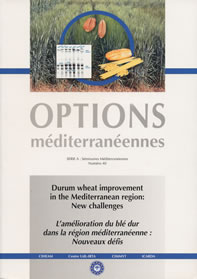| Article précédent | p. 497-499 | Article suivant |
Lipoxygenase in durum wheat: What is the role in pasta colour?
Bright yellow colour of durum wheat products is the result of natural carotenoid pigment content and of their oxidative degradation by lipoxygenase (LOX) activity. Such a colour depends on several factors among which intrinsic quality of semolina and processing conditions are considered to be the most important. Although pigment content and LOX level are mainly varietal characteristics, they can be affected by environmental factors. In particular, variations of transcriptional level of LOX gene-s were observed in different cultivars. The phase mainly responsible for pigment loss is pasta processing when a substantial decrease in pigment content in respect to milling occurs. The extent of this decrease was found to be highly correlated with semolina LOX activity. Therefore, a reduction of LOX activity during pasta processing is of interest for technological, nutritional, and commercial purposes. To this regard, it is shown that b-carotene as well as the antioxidant alpha-tocopherol and L-ascorbate, inhibit semolina LOX activity.
- [ Afficher ]
- [ Télécharger ]
- [ Exporter la citation ]
Vous pouvez télécharger la citation au format :
- [ Imprimer ]
-
Mots-clés
BLE DUR, CAROTENOIDE, INHIBITION, LIPOXYGENASE, PATE ALIMENTAIRE, PIGMENTCiter cet article
Borrelli G.M., Troccoli A., Fares C., Trono D., De Leonardis A.M., Padalino L., Di Fonzo N., Pastore D., Del Giudice L. Lipoxygenase in durum wheat: What is the role in pasta colour?. In : Royo C. (ed.), Nachit M. (ed.), Di Fonzo N. (ed.), Araus J.L. (ed.). Durum wheat improvement in the Mediterranean region: New challenges . Zaragoza : CIHEAM, 2000. p. 497-499. (Options Méditerranéennes : Série A. Séminaires Méditerranéens; n. 40). Seminar on Durum Wheat Improvement in the Mediterranean Region: New Challenges, 2000/04/12-14, Zaragoza (Spain). http://om.ciheam.org/om/pdf/a40/00600082.pdf



